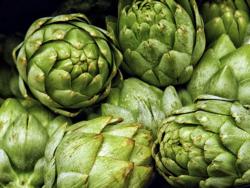Artichoke
 UC Links
UC Links

How to grow
- Growing Artichokes
- Grow and harvest artichokes [video, 4:10]
Pest management: Artichoke Pest Management
The Basics
Artichokes are considered a cool season crop but can be grown as a perennial in Santa Clara County. They require lots of sun, plenty of water, and occasional protection from frost.
When to plant: September–October
Harvest window
- Two crops per year can be expected. After spring harvest, cut off the old stalks just below ground. New shoots will develop and produce a fall crop.
- Each flowering stem produces one large artichoke at the tip and several smaller ones below.
- Harvest the central bud first, when scales are tightly closed and the globe is about the size of an orange. The stem should still be supple 2 inches beneath the globe.
- Avoid artichokes that have already begun to open as they will be tough in texture.
Care overview
- Artichoke plants reach a height of 3 or 4 feet and a spread of up to 6 feet in diameter, so allow plenty of space for them to grow. Don't plant them near tree roots, as they don't compete well for nutrients and water.
- Artichokes have an appetite for nitrogen. When planting, mix manure, compost, or other organic matter into the first foot of soil in about equal volumes.
- During the growing season, the artichoke needs to be irrigated about once weekly.
- After spring harvest, cut old stalks just below ground level. New shoots will develop and produce a fall crop.
More links
Recommended Varieties for Santa Clara County*
| Artichoke Violetto Precoce, OP | Mid-early violet purple artichoke with medium-sized, thorn-free globes. Tight, thick leaves are deliciously meaty yet tender. Very traditional Italian variety. |
| Green Globe | Accounts for over half of the artichoke production in California. Sharp spines with large, heavy, consistent-quality, globe-shaped heads. Also known as Vert Globe. |
| Imperial Star | Grows 3–4 feet tall and bears 3 to 8 4-inch-diameter spineless buds. |
* Many other varieties may also do well here in Santa Clara County. This list is based on UC Master Gardener trials, taste tests, and feedback from local growers.






